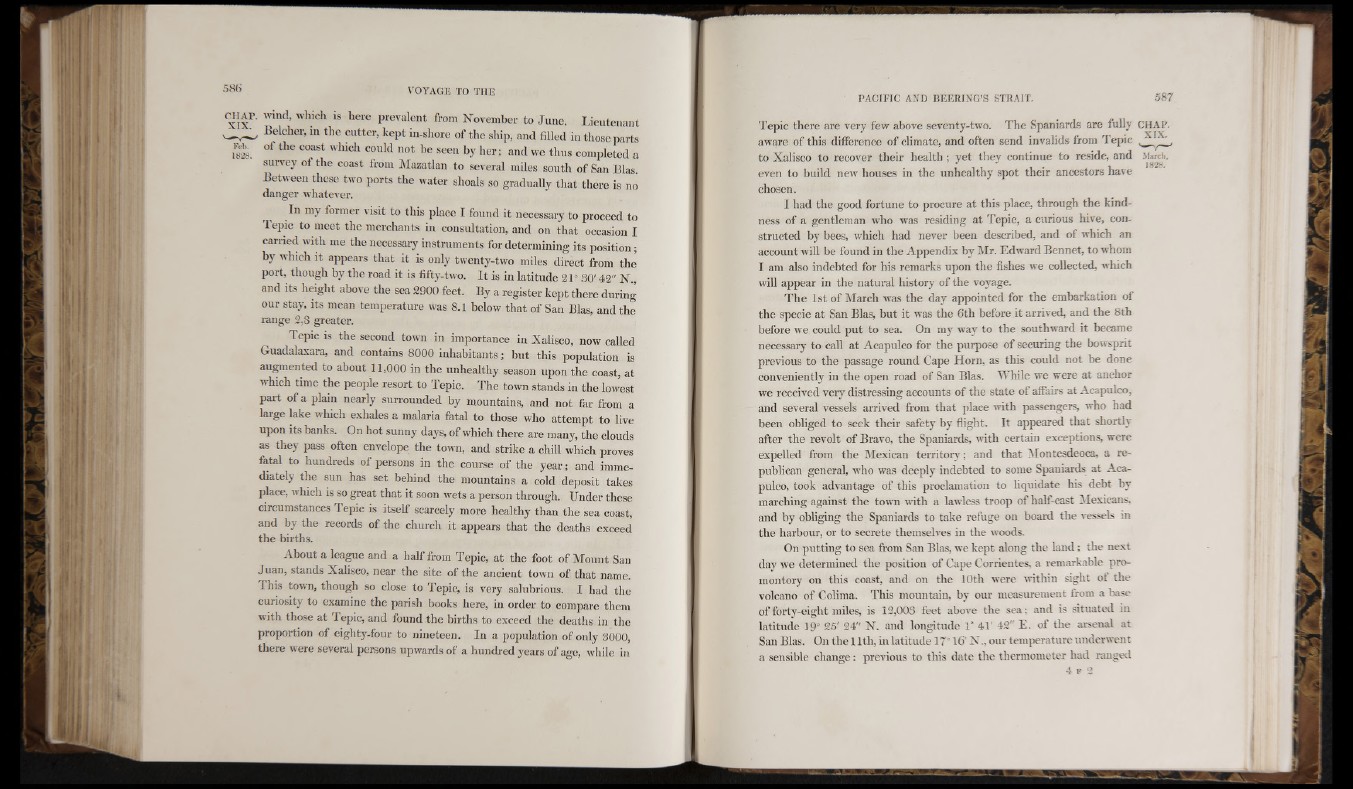
iviud, which is Iiero prevalent from November to June. Lieutenant
Belcher, in the cutter, kept in-shoro of the ship, and filled in those parts
ot the coast whicli could not be seen by her; and wc thus completed a
survey o fth e coast from lAIazatlau to several miles south of San Bias
Between these two ports the water shoals so gradually that there is no
danger whatever.
In my former visit to this place I found it necessary to proceed to
Tepic to meet the merchants in consultation, and on that occasion I
carried with me the necessary instruments for determining its position;
by which it appears that it is only twenty-two miles direct from thè
port, though by the road it is fifty-two. It is in latitude 21° 30' 42" N.,
and its height above the sea 2900 feet. By a register kept there during
our stay, its mean temperature was 8.1 below that of San Bias, and the
range 2,8 greater.
Tepic is the second town in importance in Xalisco, now called
Guadalaxara, and contains 8000 inhabitants ; but this population is
augmented to about 11,000 in the unhealthy season upon the coast, at
which time the people resort to Tepic. The town stands in the lowest
part of a plain nearly surrounded by mountains, and not far from a
large lake which e.xhales a malaria fatal to those who attempt to live
upon its banks. On hot sunny days, of w-hich there are many, the clouds
as they pass often envelope the tow-n, and strike a chill which proves
fatal to hundreds of persons in the course of the year ; and immediately
the sun has set behind the mountains a cold deposit takes
place, which is so great that it soon wets a person through. Under these
circumstances Tepic is itself scarcely more healthy than the sea coast,
and by the records of the church it appears that the deaths exceed
the births.
About a league and a half from Tepic, at the foot of Mount San
Juan, stands Xalisco, near the site of the ancient town of that name.
This town, though so close to Tepic, is very salubrious. I had the
curiosity to examine the pari.sh books here, in order to compare them
with those at Tepic, and found the births to exceed the deaths in the
proportion of eighty-four to nineteen. In a population of only 3000,
there w-ere several persons upwards of a hundred years of age, wliilc in
Tepic there are very few above seventy-two. The Spaniards are fully CH.AP.
aware of this difference of climate, and often send invalids from Tepic ._____
to Xalisco to recover their health ; yet they continue to reside, and .vbrd,.
even to build new houses in the unhealthy spot their ancestors have
chosen.
I had the good fortune to procure at this place, through the kindness
of a gentleman who was residing at Tepic, a curious hive, constructed
by bees, which had never been described, and of which an
account will be found in the Appendix by Mr. Edward Bennet, to whom
I am also indebted for his remarks upon the fishes we collected, which
will appear in the natural history of the voyage.
The 1st of March was the day appointed for the embarkation of
the specie at San Bias, but it was the 6th before it arrived, and the Sth
before we could put to sea. On ray way to the southward it became
necessary to call at Acapulco for the purpose of securing the bowsprit
previous to the passage round Cape Horn, as this could not be done
conveniently in the open road of San Bias. While we were at anchor
we received very distressing accounts of the state of affairs at Acapulco,
and several vessels arrived from that place with passengers, who had
been obliged to seek their safety by flight. It appeared that shortly
after the revolt of Bravo, the Spaniards, with certain exceptions, were
expelled from the Mexican territory; and that IMontesdeoca, a republican
general, who was deeply indebted to some Spaniards at Acapulco,
took advantage of this proclamation to liquidate his debt by
marching against the town with a lawless troop of half-cast ^Mexicans,
and by obliging the Spaniards to take refuge on board the vessels in
the harbour, or to secrete themselves in the woods.
On putting to sea from San Bias, we kept along the land; the next
day we determined the position of Cape Corrientes, a remarkable promontory
on this coast, and on the JOth were within sight of the
volcano of Colima. This mountain, by our measurement from a base
of forty-eight miles, is 12,003 feet above the sea: and is situated in
latitude 19" 25' 24" N. and longitude 1' 41 42" E. of the arsenal at
San Bias. On the 11th, in latitude IT' 16' N ., our temperature underwent
a sensible change: previous to this date the thermometer had ranged
4 F 2